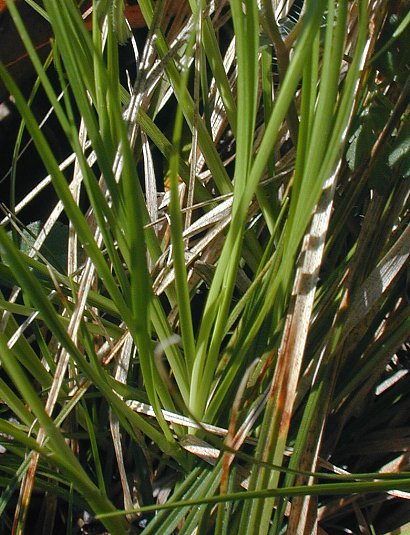Description: This perennial sedge forms small loose tufts of leafy culms about ½–1¼' tall; both fertile and sterile shoots occur. The culms are unbranched, light green, sharply 3-angled, and glabrous; they have alternate leaves. The leaf blades are 1-3 mm. across; they are usually shorter than the fertile culms, but longer than the sterile culms. The leaf blades are light green, glabrous, and furrowed along their midveins; they are ascending to widely spreading and arching. The leaf sheaths are light green, longitudinally veined, and glabrous. Each fertile culm terminates in an inflorescence consisting of a terminal staminate spikelet, 2-3 pistillate spikelets, and their bracts. The narrow staminate spikelet is 1.0–2.5 cm. long on a short peduncle. The staminate scales of this spikelet are 3.5–5.0 mm. long, 1.5 mm. across, and lanceolate or elliptic in shape; they are dark purple during the blooming period, often with green midveins and membranous margins. The large anthers of the staminate florets are cream-colored and linear in shape; they become dull light brown with age. The sessile pistillate spikelets are much smaller in size than the staminate spikelet; they are adjacent to each other or slightly separated. Each pistillate spikelet has about 4-12 perigynia and their scales.

The perigynia are
2.5–3.0 mm. long and 1.5 mm. across; they have ovoid-globoid bodies
with short
stout beaks and stipe-like bases that are also short and stout.
Immature perigynia are light green and either glabrous
or finely short-pubescent. The pistillate scales are about the same
length as the perigynia; they are ovate in shape, dark purple, and
membranous along their margins. Each pistillate floret has 3 styles
that are slender and white. At the base of the lowest pistillate
spikelet, there is a green to purple leafy bract that is as long or a
little longer than the spikelet (up to 1 cm. in length). Other bracts
of the inflorescence are smaller in size and often scale-like. The
blooming period occurs from mid- to late spring, lasting about 1-2
weeks. The florets are cross-pollinated by the wind. The achenes are
about 1.5–2.0 mm. long, globoid-obovoid in shape, and slightly
3-angled. The root system produces long stolons than run along the
surface of the soil (underneath fallen leaves and other debris). Loose
clonal colonies are often formed from these stolons.
Cultivation:
Pennsylvania Sedge prefers partial or dappled sunlight and mesic to dry
conditions with good drainage. A sandy loam or loose loam with abundant
organic matter is preferred; this sedge also adapts to thin rocky soil
if there is a layer of loam and decaying organic matter on top.

Range &
Habitat:
The native Pennsylvania Sedge is occasional to locally common in most
areas of Illinois; it is least common in south-central Illinois (see Distribution
Map). Habitats include upland woodlands, thinly
wooded bluffs, wooded slopes, sandy savannas, rocky or sandy
openings in wooded areas, hill prairies, and upland prairies. This
sedge is often found in dry woodland areas where oak trees (Quercus spp.)
are present.
Faunal Associations:
Insects that are known to feed on Pennsylvania Sedge include the
leafhopper Cosmotettix delector, the aphid Iziphya albipes,
and such grasshoppers as Arphia pseudonietana
(Red-winged Grasshopper), Orphuella speciosa
(Pasture Grasshopper), and Trachyrhachys kiowa
(Kiowa Grasshopper). Other insects that feed on sedges (Carex spp.) include
larvae of the grass-miner moths Elachista
argentosa and Elachista
madarella, Chloealtis
abdominalis (Thomas' Broad-winged Grasshopper), and such
aphids as Iziphya
flabella, Carolinaia
caricis, and Vesiculaphis
caricis
(Panzer et al., 2006; Wyoming Agr. Exp. Sta., 1994; Vickery &
Kevan, 1985; Microleps website, 2010; Blackman &
Eastop, 2013). Various birds eat the seeds of sedges in habitats
that are favored by Pennsylvania Sedge; these species include the
Greater Prairie Chicken, Wild Turkey, immature Ruffed Grouse, Eastern
Towhee, and various sparrows (Martin et al., 1951/1961). Sedges in
such habitats are a source of food to the Prairie Vole as well.

Photographic
Location:
Wooded slopes in Vermilion County, Illinois.
Comments:
This is one of the first sedges to bloom during the spring.
Pennsylvania Sedge (Carex
pensylvanica) is very similar to Carex lucorum
and Sun Sedge (Carex heliophila); these latter two
species are sometimes considered different varieties of Pennsylvania
Sedge (e.g., Carex pensylvanica distans and Carex
pensylvanica digyna respectively). Compared to Pennsylvania
Sedge, these species/varieties have longer perigynia (3.0–4.0 mm. in
length). The perigyneal beaks of Carex lucorum are
more slender and long than those of Pennsylvania Sedge, while Sun
Sedge has leaf blades that are more stiff and revolute (rolled). Two
other species that are similar in appearance, Carex
communis and Carex
albicans, lack the
long stolons of Pennsylvania Sedge. Most of these species prefer
similar habitats to Pennsylvania Sedge, although Sun Sedge is more
common in the open prairies of the Great Plains states.